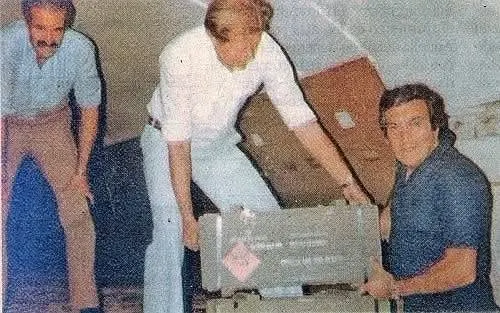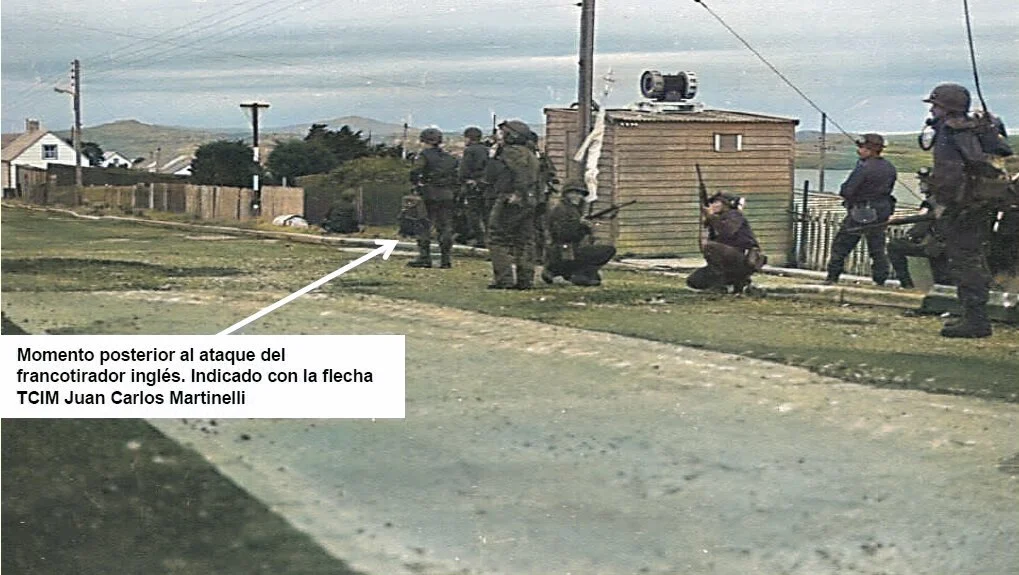
ARA Hércules (D-28 / D-1 / B-52)
The fast transport ship ARA Hércules (B-52) (TRHE) was a multipurpose rapid transport vessel of the Argentine Navy. It was built in the 1970s as a Type 42 destroyer and, following a refit in the 1990s, was reclassified as a fast transport. It was officially decommissioned and the national ensign was finally lowered on 20 June 2024, after 48 years of service.
Armed with Sea Dart surface-to-air missiles, its mission — along with its sister ship, the destroyer ARA Santísima Trinidad (D-2) — was to provide area air-defence for the light aircraft carrier ARA Veinticinco de Mayo (V-2), operating via data link.
History
The vessel was originally built as a Type 42 destroyer, similar to the units of the same class commissioned by the British Royal Navy. It was constructed at the Vickers Shipbuilding yard in Barrow-in-Furness, United Kingdom, concurrently with the HMS Sheffield, the lead ship of the British series, which was sunk during the Malvinas War.
Following an irreparable fire that destroyed the stern of HMS Sheffield, a complete stern section from ARA Hércules was used in the British vessel. As a result, the Vickers 4.5" (115 mm)/55 Mk 8 automatic naval gun mounted on the British ship originally belonged to the Argentine destroyer.
F
The vessel was built as a Type 42 destroyer, similar to those commissioned by the British Royal Navy. It was constructed at the Vickers Shipbuilding yards in Barrow-in-Furness, United Kingdom, concurrently with HMS Sheffield, the lead ship of the British class, which was later sunk during the Falklands War. After an irreparable fire destroyed the stern of HMS Sheffield, a full stern section from ARA Hércules was used to repair her. As a result, the Vickers 4.5" (115 mm)/55 Mk 8 automatic gun mounted on the British ship originally belonged to the Argentine vessel.
She was delivered to the Argentine Navy and entered service on 19 September 1977. Upon commissioning, she was assigned to the 1st Destroyer Division as the guided missile destroyer ARA Hércules (D-28), DEHE, with Puerto Belgrano Naval Base as her home port. When her sister ship ARA Santísima Trinidad (D-2) joined the fleet, Hércules was redesignated as D-1, under which she operated until her conversion into a fast transport.
Several Argentine Navy ships have carried the name “Hércules”, but the most iconic remains the flagship of Admiral Guillermo Brown during the wars of independence — the famous “Black Frigate”, so named for her dark sails. The legacy of the name Hércules lives on today through this troop transport vessel.
Beagle Conflict
In December 1978, as part of Operation Soberanía, ARA Hércules formed part of Task Group 2 alongside the aircraft carrier ARA Veinticinco de Mayo (V-2), with the mission to militarily occupy Lennox, Nueva and Picton Islands and Cape Horn, then in dispute with Chile. The operation was ultimately not carried out, and the Argentine Fleet began its withdrawal to Puerto Belgrano.
Malvinas War
In 1982, together with her sister ship ARA Santísima Trinidad (D-2), ARA Hércules took part in escorting ARA Veinticinco de Mayo during the Malvinas War. She participated in the initial landings to recover the islands, and her embarked helicopter operated for several hours at Puerto Argentino Airport.
In early May, the Argentine Task Force anticipated a naval air engagement with the British Royal Navy’s Task Force. At one point, Hércules’ early warning radar detected a Sea Harrier from HMS Invincible being vectored to intercept a Grumman S-2 Tracker launched from Veinticinco de Mayo, which was attempting to locate the British fleet for a coordinated strike. However, favourable conditions for such an attack never materialised, and the Argentine ships withdrew to shallower waters, beyond the threat range of British nuclear submarines. Hércules continued operating in coastal patrol zones near the Argentine mainland.
Post-war
Following her service in the 1st Destroyer Division and later her reassignment to the Amphibious Naval Command, ARA Hércules regularly participated in naval exercises — known as “Etapas de Mar” — alongside other vessels of the Sea Fleet, the Maritime Patrol Division, the Submarine Force, as well as aircraft and helicopters of Naval Aviation, and in amphibious exercises with the Marine Corps. She also took part in joint naval operations with foreign forces.
In 1988, she visited the port of Buenos Aires along with most ships of the Sea Fleet, including her sister ship D-2.
In 1993, she carried out her final live-fire exercise with a GWS-30 Sea Dart missile. From that point, she began operating with spare parts salvaged from ARA Santísima Trinidad (D-2), which had been inactive since 1989 and was progressively cannibalised.
In 1994, she was transferred to the Amphibious and Logistics Naval Command (COAL), and by 1999, she underwent a major conversion into a fast transport vessel, with substantial modifications to her flight deck and helicopter hangar to accommodate two Sea King medium helicopters. These works were carried out at the Chilean Navy’s ASMAR shipyard in Talcahuano, with final completion between 2004 and 2006 at the Puerto Belgrano Naval Arsenal in Argentina.
In 2009, her Sea Dart missile launcher was removed, and the space was converted to house four MKV assault boats for the Argentine Marine Corps.
Among her deployments, she took part in the 1998 edition of the combined exercise “UNITAS”, and the amphibious phase of Exercise “Fraterno” in 2006. As a troop transport unit, she continues to participate in amphibious operations and all phases of fleet manoeuvres. In 2009, she underwent a major overhaul at CINAR (Argentine Naval Industrial Complex), rejoining the fleet in April of that year after maintenance of her hull, valves, and systems. That same year, she participated in a maritime control patrol and the search for survivors of the fishing vessel Atlantic, lost during a storm.
Between 2004 and 2012, she took part in all amphibious training exercises of the Sea Fleet, including the “Inalaf” exercises with embarked Marine Corps personnel from the Chilean Navy. During the same period, she also hosted training voyages for cadets of the Argentine Naval Academy (ESNM) along the national coastline, visiting ports such as Ushuaia and Puerto Madryn.
2010s
The vessel continued its annual live-fire training, amphibious exercises, and fleet manoeuvres, as well as port visits along the Argentine coast (such as Necochea) and training cruises with cadets from the Naval Academy and midshipmen from the Petty Officers’ School of the Navy.
Conversion
The ship underwent an initial conversion process in Chile (at ASMAR, the Chilean Navy’s shipyard) and later in Argentina (at the Puerto Belgrano Naval Base, ARPB) during the late 1990s. Modifications included an expanded flight deck and hangar to accommodate and operate two Sea King helicopters armed with Exocet AM39 missiles, and an upgrade of its electronic systems, with INVAP, Argentina’s state technology company, contributing to additional systems reengineering.
Subsequently assigned to the Amphibious Naval Command, the ship began operating as a multipurpose fast transport under its new permanent designation: B-52. Its redesign allowed it to function as a fast troop landing ship. Interior spaces were converted into troop berths for embarked Marine Corps (IM) personnel.
The two radar domes (Type 909) and the Sea Dart missile launcher on the foredeck were removed. The vessel is equipped with a fully Argentine-developed Automated Command and Control System (SITACC), implemented through the SIAG-2006 platform. These upgrades also allowed the integration of a Combat Information Centre (CIC) for the KFD General Staff when embarked, and the installation of eight external mountings for safely securing MK V assault boats used by the Marine Corps.
The hangar doors were once again overhauled and modified by INVAP, and currently operate without major issues. For surface-to-air defence, RBS-70 missiles are deployed on an elevated aft platform with internal communications, where they are mounted during training voyages that include live-fire exercises.
Decommissioning
The vessel had been held in reserve status since 2013. It was officially decommissioned on 22 March 2024, and the final lowering of the ensign took place at Puerto Belgrano on 20 June 2024. The ship now awaits its final disposition.
Specifications
Original
Engines
-
2 Olympus TM38 gas turbines, 50,000 HP
-
2 Tyne RM1A gas turbines, 9,900 HP
-
2 propellers
Colours
-
Hull and superstructure, including launchers, domes, lower mast sections, flight deck, and other surfaces painted in matte Admiralty grey
-
Underwater hull (anti-fouling) in red anti-rust coating
-
Waterline, mast tops, and funnel in matte black
-
Flight deck marked with a white circle and white identification number with black shadow
General Characteristics
-
Sister ship of the HMS Sheffield, which was destroyed and sunk at 53°04′S 56°56′W
-
Standard displacement: 3,150 tonnes
-
Full load displacement: 4,100 tonnes
-
Length between perpendiculars: 119.50 metres
-
Beam: 14.63 metres
-
Maximum draught: 6.8 metres
Propulsion system
-
COGOG configuration:
-
2 Rolls-Royce Olympus MM3B gas turbines delivering 54,900 HP for maximum speed
-
2 Rolls-Royce Tyne gas turbines providing 8,200 HP for cruising speed
-
Crew
-
Between 300 and 312 personnel
Additions from the Conversion
The cantilevered flight deck and stern openings allow for the rapid deployment or recovery of inflatable boats ("Zodiacs") used by special forces. The ship is capable of carrying 238 fully equipped marines without any reduction in her maximum speed of 30 knots.
INVAP redesigned the hangar door system as well as made certain modifications to the stern section of the vessel. The door is operated both electromechanically and manually, with a minimum opening width on each side of 6.2 metres and a height clearance of 5.4 metres. It is weatherproof and blocks exterior light radiation. The minimum opening/closing speed is 10 cm/s, and the maximum manual opening time is 5 minutes, under conditions of rolling, pitching, permanent list, and extreme wind pressure (with lateral inclination up to 30° and frontal inclination up to 10°, simultaneously).
The ship also features expanded accommodation capacity to transport a reinforced Marine Infantry Company, a dedicated operations room for the embarked Marine General Staff, and two fully equipped classrooms.
Its two 909 radomes and the Sea Dart missile launcher were removed. The deck has since been fitted with metal racks and electric winches for transporting MK-V landing craft, as well as a cargo hold for storing equipment.
Electronics
Navigation
-
2 GPS systems, integrated with the digital chart system and providing cartographic display both on the bridge and in the Combat Information Centre (CIC) via LCD screens
-
1 digital log
-
1 echo sounder
-
3 VHF radio units for maritime safety
Command and Advisory System
-
Command and Advisory System – SITAC 2006
-
Integrated consoles with visual interface
-
Designed and installed domestically by SIAG – Puerto Belgrano (2006)
Communications
- HF - UHF y VHF (Low Band) Equipment
- Datalink- LINK ARA.
Radars
- Long-range Air Search - Marconi 965 (IFF).
- Surface Search - Marconi 992.
- Kelvin Hughes 1006 Helicopter Control.
- DECCA 1229 Navigation.






















